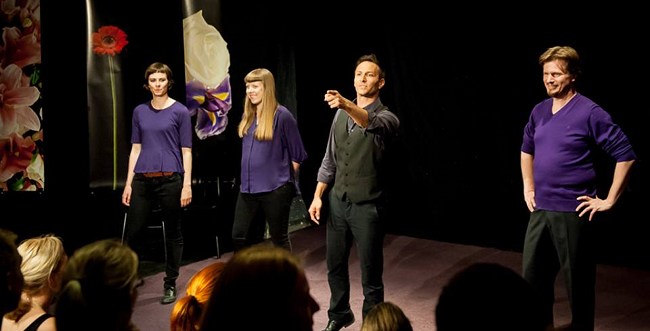How Improvisation Is Used Well in Comedy
By Melanie Hope
Summary: ‘‘ Whether you are a working on becoming a standup comedian or a humorous keynote speaker, the ability to improvise can often save your bacon. Luckily for you, improv can be learned and honed. These three techniques will show you how to get started ‘‘
The ability to improvise - or make something up on the fly - is a useful tool to have in your arsenal no matter what task is at hand. If you are a standup comedian or humorous speaker, however, improvisational skills are critical.
As a comedian, the most beneficial time to be able to improvise is when you have a joke fall flat. It's never a good thing to ignore when you've lost your audience or you've dropped a dud. With a few improv techniques, you can go from crickets to giggles or groaning. Either way, you'll have them back on your side.
Following are a couple of comedy techniques that lend well to improvisation:
Self-effacing humor
When you are delivering a comedy routine, the goal is to get the audience on your side. The more they agree with you, feel your pain, or just like you, the more they are willing to laugh. When you tell a joke that no one laughs at, you can poke fun at yourself and get them to laugh at that instead.
One of the masters of this technique was Johnny Carson. During one of his famous monologues, when he realized he wasn't getting any laughs, he told the audience, "Come on folks, it's better to give than receive." When someone laughed particularly loud, he looked bewildered and said, "Where did that laugh come from?" He then looked off stage and laughed to himself, saying, "Oh, the staff!" He got the audience back on board, laughing with him. For the rest of the monologue, he poked fun at his own inability to deliver it, from acting like he had a mouthful of peanut butter to saying, "Well, I'm just going to keep plugging away at this." He got more laughs at poking fun at himself than at any of the pre-written jokes.
Folks would rather laugh with you than at you, so don't be cruel to yourself. It's a tough line to straddle. Keep it real, but keep it light.
Observational humor
You may have seen or heard something on your way to the stage that you can use somewhere in your set - and this spur-of-the-moment comment may get the biggest laugh of the night. What you are looking for is a shared experience between you and the audience, a large-scale inside joke, if you will.
One of the best examples of observational humor is Robin Williams. He could walk into a room and do nothing but talk about aspects of the room and have people rolling in the aisles with laughter.
As a keynote speaker, doing a bit of homework will help. Know the names of your hosts, the names of the bosses, and a quirk or two about the organization you can build on. Get a feel for the room, what people are saying about the food or climate, and keep your eyes open for anything out of the ordinary that may happen along the way.
As a comedian, it's a good way to handle a heckler or technical issues. Make the jokes lighthearted and inviting. The more inclusive, the more fun your audience will have. Try to take them by surprise, but make it easy for them to recognize what you're doing. People love being in on the joke.
Callbacks
If an earlier joke went particularly well - or particularly bad - you can call back on it later and recycle the laugh, sometimes even heighten it. Again, you are going for the shared experience with your audience. If you can refer to something someone else who came on before you said, all the better! It will both get a laugh and make you look like a genius.
Improvised callbacks only work in that moment, however. These aren't jokes that you can use later at another venue because no one will understand them. You could try to explain it, but the setup might take too long, and it won't be fun anymore. If you find yourself thinking, "You had to be there," leave it there.
I was the last act in a standup expose at a club in Las Vegas, judged by some big names on the Strip. When the first comedienne was bashed by the judges because she didn't move the microphone stand and almost tripped over it during her set, may of us incorporated the microphone stand into our sets, from using it as a cane to make it across the stage, to hiding behind it when a joke didn't get laughs. Even when the joke preceding it didn't work, the callback did.
The trick to this improv technique is to make it both flow naturally, and yet still be unexpected. If it sounds forced, is overused, or is esoteric, it just won't be funny.
Practice and combine!
As you can see, these techniques can overlap in several areas, yet all rest in your ability to have confidence to make something up in the moment. Much like your comedy routine, improv is a skill that you can develop. Give yourself assignments to practice making things up. Watch other comedians and how they react to unexpected situations. Try it out as often as you can, and it will get easier and more natural.
M�lanie Hope is an award-winning humorous speaker and the author of "Improv Your Bottom Line: Surge your sales and strengthen your team with the secrets of improvisation." Contact her via http://hopespeaking.com
Article Source: http://EzineArticles.com/?expert=Melanie_Hope
http://EzineArticles.com/?How-Improvisation-Is-Used-Well-in-Comedy&id=8878946
keywords:
comedy,improvisation,humor,standup,speech,speaking,improve










No comments :
Post a Comment